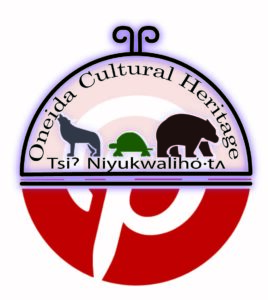About Cultural Heritage
The mission of Oneida Cultural Heritage is to provide Lotinuhsyuni knowledge and resources to strengthen Tsi Niyukwaliot^.
The Cultural Heritage Department is comprised of multiple programs that maintain and interpret Oneida traditional teachings, customs and history. These programs preserve and protect the artifacts, collections, documents, audio and visual recordings for reference and research including Oneida language material. The Cultural Heritage Department offers numerous learning opportunities that promote the dignity and respect of the Oneida people and culture.
Cultural Heritage Department is divided into three clans based on the Oneida Clan System. Wolves are the pathfinders, giving us the path of direction, we are going. The turtles understand the environment and are recognized as being the well of information. Bears are the medicine people. Within Cultural Heritage, each of these clans has a manager. When a matter arises that will impact the department, the three clans work together and deliberate over the topic using the Clan System.
Stephenie Muscavitch VanEvery is the Wolf Clan Manager. The wolf clan provides reports to leadership, facilitates department meetings, and manages the programs and services that provide direction and leadership. The wolf clan consists of the Language and Culture Archivist and Educators, Oneida Language Development Specialist, and the Office Manager.
Nicholas Metoxen, the Turtle Clan manager, collaborates with internal tribal resources and oversees the programs that serve the community and provide information to the people. The turtle clan is composed of the Oneida Nation Arts Program, Tribal Historic Preservation Office, and the Oneida Museum.
The Bear Clan manager, Tsyoshaaht Delgado, coordinates employee engagement and morale, oversees all safety plans, and manages programs and services that support health and wellness. The Traditional Healer and Cultural Advisor programs are part of the Bear Clan.
The Clan System is used as a model for the way business is conducted in the Cultural Heritage Department. For example, within the Clan System, there are certain steps taken to ensure the voice of the people is heard.
Step 1: The wolf clan recieves the matter and sets an agenda, and sends the information to the turtle clan.
Step 2: A clan meeting is held; men, women, children and elders are given a chance to speak. The topic, research, and concerns are given to the bear clan.
Step 3: The bear clan recieves the information and after discussion, establishes dialogue with the turtle clan.
Step 4: A unified decision is made and sent to the wolf clan for action.
Cultural Heritage implements this philosophy when a matter arises that impacts the entire department. The wolf clan gathers information about the matter and presents it to the other clans. The clans individually deliberate, collaborate, and reach a consensus. Once an agreement is made, they provide their recommendation to the Wolf Clan, which will then chart the path forward and offer guidance.









